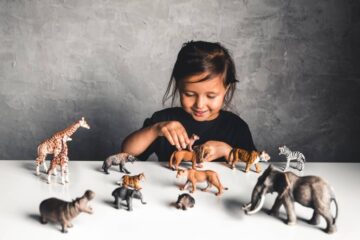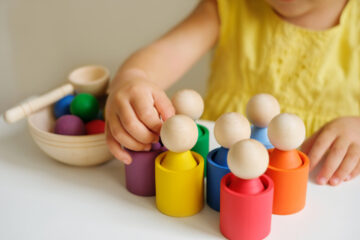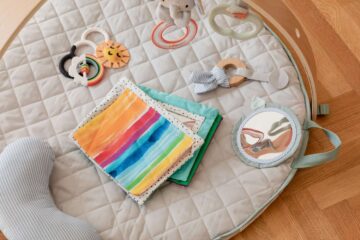
Evolution of Kids Toys in Pakistan
Kids have always loved toys. The first toys were created of natural materials like sticks, pebbles, and stone. They even played with animal bones. According to several kids, back in 4000 B.C., they even played with animal bones. Children’s toys have changed throughout the years and over the ages. Plastic replaced natural materials. Technology was introduced to the forefront of the toy business with the development of talking toys, video game consoles, and tablets, which permanently altered how kids play.
Lovevery prepared a list of 15 toys, games, and gadgets to demonstrate the evolution of children’s play by researching the history of childhood play and development.
The toys on this list include a classic puzzle that every child of the 1980s wanted to solve, a toy that was unintentionally created with a cleaning product, and a toy that began as art therapy and encouraged children to express themselves and become dirty. They stand for more than 200 years of enjoyment and recreation. Each toy fosters or sharpens a fundamental childhood ability, such as imagination, creativity, skill, and self-control. These toys are still in use, albeit in more modernized versions.
Join Lovevery as it explores the evolution of play via a thought-provoking history of toys.
- kaleidoscope
The original kaleidoscopes were composed of metal and brass and were created by Scottish scientist David Brewster. These were extremely popular in London among both youngsters and adults. The invention of picture tubes encouraged artistic expression and gave viewers a window into unique works of art. In addition to being fascinating, kaleidoscopes may be used to teach kids about scientific concepts like light reflection.
- Dolls Martha Chase
The fact that Martha Jenks Chase was the wife of a doctor and a seamstress aided her in pursuing her doll-making endeavor. Chase’s soft dolls encouraged kids to treat their dolls like babies instead of being put off by the hefty and harsh European beauties. She didn’t like American mechanical dolls either since she believed technology limited kids’ ability to use their imaginations when playing. Barbie and Cardiff University neuroscientists performed a 2020 research that discovered evidence to support the idea that doll play activates brain areas related to feelings of empathy and social information processing.
- Raggedy Ann dolls
Johnny Gruelle, a painter and illustrator, was granted a patent in 1915 for the Raggedy Ann doll. Gruelle’s daughter Marcella, who could have contributed to the doll’s inspiration, passed away at 13. Even though Raggedy Ann was originally a doll, Gruelle’s writings for youngsters about compassion in 1918 are what first popularized the character.
- Radio Flyer wagon
This well-known and cherished wagon evokes memories of parents pushing their kids through neighborhoods. The movable cart was employed by many young children to assist them on their paper routes, developing intrepid businesspeople. Antonio Pasin, an Italian immigrant, designed the steel wagons.
- Pop-up books
Although pop-up books have been present since the 14th century, the “Daily Express Children’s Annual No. 1” by S. Louis Giraud and Theodore Brown was the first in a series of pop-ups. The books gave reading a new lease of life by introducing three dimensions to young readers worldwide.
- Hand painting
A teacher from the United States named Ruth Faison Shaw created finger painting as a type of art therapy for kids. In “Finger Painting, a Wonderful Media for Self-Expression,” her book emphasized the need to let kids be kids, even if it meant getting dirty. The idea grabbed on, and finger painting shot to fame and stayed there, giving youngsters everywhere a creative and enjoyable outlet for self-expression.
- Legos
Ole Kirk Christiansen, a Danish carpenter, developed the concept for the first Legos, a set of red and white interlocking bricks. The Danish word “leg godt” is the source of the word “lego,” which means “play well.” The first patent for plastic toys was not issued until 1958. Children may improve their fine motor and spatial abilities by playing with Legos or other blocks. Some experts think that block play may create the groundwork for STEM education.
- Fashion dolls
Modern fashion dolls first gained popularity with the adult-targeted German fashion doll Bild Lilli. The doll’s rights were purchased by Mattel, who renamed her “Barbie” and started selling her in 1959. Although Barbie has been controversial throughout the years, the doll generally promotes imaginative play. It is even seen as a role model by many. Barbies with a broader range of origins, passions, and accomplishments have been presented throughout the past several years, as have the doll’s body proportions and look.
- Action figures
Hasbro promoted the G.I. Joe doll to young boys as their version of Barbie and is credited with creating the first action figure. A television program about the “true American hero” was also inspired by him, and males could be seen playing with their sisters. More action figures would appear, frequently associated with popular culture. G.I. Joe significantly contributed to dispelling, or at the very least reducing, the stigma associated with boys playing with dolls.
- Video game console
The Magnavox Odyssey and the Atari video game console, developed by Ted Dabney and Nolan Bushnell, were released in 1972. Video gaming consoles are still widely used but frequently have a poor name. Yet, studies have shown that playing video games helps with hand-eye coordination and response time.
- swaying tower
Kids and adults now have a fun—though sometimes stressful—game to play thanks to the introduction of Jenga, which involves stacking and removing blocks from a tower. There have been new construction towers that have even entered the educational sector. They can assist in teaching children self-control and patience. They are accommodating as a sensory aid to enhance fine-motor abilities and hand dexterity.
- Before the mid-2000s: STEM coding toys
Digital literacy has become more critical as electronics have become more prevalent, particularly as instructional tools. Youngsters may now learn how to program electronic gadgets in addition to how to utilize them. These toys, which might be simple or complex, aid children in honing their talents in math, science, technology, engineering, and other related fields.
Yet, even though tablets and other electronic devices provide tools that may be helpful from the perspective of learning, experts advise restricting screen time for infants and young children. The World Health Organization recommends that children under five should not spend more than an hour a day using screens and that less is preferable. Babies under 18 months should not be exposed to screens at all. According to a 2019 study published in JAMA Pediatrics, children who spent more time in front of screens had lower amounts of white matter in their brains that supports the growth of their cognitive, linguistic, and literary abilities.
















